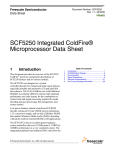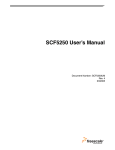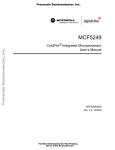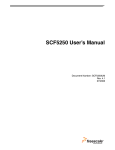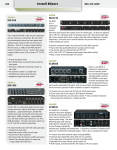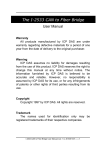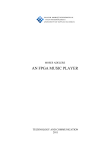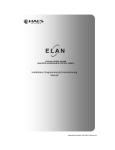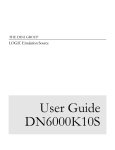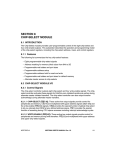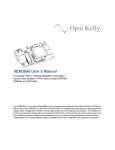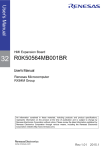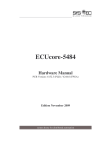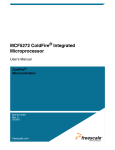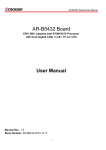Download M5253 Demo Board User Manual
Transcript
Freescale Semiconductor User Guide Rev. 0, 10/2008 M5253 Demo Board User Manual For M5253 Demo Evaulation/Application Development by: Shen Li System Engineer, Shanghai The M5253 demo board is based on the Freescale V2 architecture family chip, the MCF5253. This board is shipped with the MCF5253 populated to show the functionality of this family. This board is designed as a validation platform with the maximum flexibility. It serves as a complete microcomputer system for reference design, development/evaluation, training, and educational use. Further more, the board also includes an ethernet controller on the system FlexBus for debugging and developing purposes. © Freescale Semiconductor, Inc., 2008. All rights reserved. Contents 1 Demo Board Overview . . . . . . . . . . . . . . . . . . . . . . . . . . 2 1.1 Features . . . . . . . . . . . . . . . . . . . . . . . . . . . . . . . . . 2 1.2 Block Diagram . . . . . . . . . . . . . . . . . . . . . . . . . . . . . 3 2 Top-Level Memory Map. . . . . . . . . . . . . . . . . . . . . . . . . . 3 3 Hardware Submodules . . . . . . . . . . . . . . . . . . . . . . . . . . 4 3.1 Processor . . . . . . . . . . . . . . . . . . . . . . . . . . . . . . . . 4 3.2 Resets . . . . . . . . . . . . . . . . . . . . . . . . . . . . . . . . . . . 4 3.3 System Clock. . . . . . . . . . . . . . . . . . . . . . . . . . . . . . 4 3.4 Booting and Programming the Flash/EEPROM Memory . . . . . . . . . . . . . . . . . . . . . . . . . . . . . . . . . . . . . . 5 3.5 SDRAM Interface. . . . . . . . . . . . . . . . . . . . . . . . . . . 6 3.6 BDM Interfaces — Processor . . . . . . . . . . . . . . . . . 6 3.7 USB 2.0 OTG . . . . . . . . . . . . . . . . . . . . . . . . . . . . . 6 3.8 FEC . . . . . . . . . . . . . . . . . . . . . . . . . . . . . . . . . . . . . 7 3.9 ATA . . . . . . . . . . . . . . . . . . . . . . . . . . . . . . . . . . . . . 7 3.10 Interrupts . . . . . . . . . . . . . . . . . . . . . . . . . . . . . . . . 7 3.11 Timers . . . . . . . . . . . . . . . . . . . . . . . . . . . . . . . . . . . 7 3.12 I2C . . . . . . . . . . . . . . . . . . . . . . . . . . . . . . . . . . . . . . 8 3.13 QSPI . . . . . . . . . . . . . . . . . . . . . . . . . . . . . . . . . . . . 8 3.14 RS232 . . . . . . . . . . . . . . . . . . . . . . . . . . . . . . . . . . . 8 3.15 SD Card Interface . . . . . . . . . . . . . . . . . . . . . . . . . . 8 3.16 Audio Interface . . . . . . . . . . . . . . . . . . . . . . . . . . . . 8 3.17 AD Module. . . . . . . . . . . . . . . . . . . . . . . . . . . . . . . . 8 3.18 CAN Interface . . . . . . . . . . . . . . . . . . . . . . . . . . . . . 9 3.19 Power Regulation . . . . . . . . . . . . . . . . . . . . . . . . . . 9 3.20 Boot Options . . . . . . . . . . . . . . . . . . . . . . . . . . . . . . 9 3.21 Serial connector. . . . . . . . . . . . . . . . . . . . . . . . . . . 10 3.22 Parallel connector . . . . . . . . . . . . . . . . . . . . . . . . . 10 3.23 Jumpers and Headers .................................................12 Demo Board Overview 1 Demo Board Overview 1.1 Features Here is a list of the demo board features. The MCF5253’s external interfaces are: • • • • • • • • • • • • • • • • • • • Synchronous serial interface (SSI) connected to the audio codec WM8731 USB support Stand-alone USB host controller, support-enhanced host-controller interface (EHCI) USB device mode USB on-the-go mode including host capability Supports high-speed (480 Mbps), full-speed (12 Mbps), and low-speed host (1.5Mbps) operations Supports internal PHY (with UTMI+ interface) Crystal/clock On-board BDMTM ATA interface MMC/SD interface Two I2Cs Four QSPIs Two CANs Three UARTs Six 12-bit resolution ADs FlexBus with 10/100 ethernet controller Timers External interrupts Memory Subsystems: • 16-bit width SDRAM • 2 × 64 KB SRAM • 8 k on-chip BootROM • Flash device for boot code development Power: • Inputs: • 5 V (Input to the voltage regulator circuitry) • Regulated on-board voltages: — 5 V for USB-VBUS support — 3.3 V — I/O Voltage — 1.2 V — CPU-core voltage M5253 Demo Board User Manual, Rev. 0 2 Freescale Semiconductor Top-Level Memory Map 1.2 Block Diagram Figure 1. M5253 Demo Board Block Diagram 2 Top-Level Memory Map The top-level memory map for the M5253 demo board is shown below. This is best for understanding how the entire memory map of the board is set up. Table 1. Top-Level Memory Map Function Start Address SDRAM 0x0000_0000 0x00FF_FFFF 16 MB SIM MBAR End Address 0x1000_0000 0x1000_0058 Size 96B Internal SRAM0 0x2000_0000 0x2000_FFFF 64KB Internal SRAM1 0x2001_0000 0x2001_FFFF 64KB SIM MBAR2 0x8000_0000 0x8000_01FF 512B Ethernet Controller 0xE000_0300 0xE000_03FF DM9000 (CS1) FLASH (CS0) 64B 0xFF80_0000 0xFFFF_FFFF 8MB M5253 Demo Board User Manual, Rev. 0 Freescale Semiconductor 3 Hardware Submodules 3 Hardware Submodules This section describes the major sections of the M5253 demo board. 3.1 Processor The MCF5253 processor is the fundamental control chip on the M5253 demo board. This is a version 2 (V2) ColdFire processor running at a maximum core speed of 140 MHz. MCF5253 implements an 8 KB instruction cache, three UART channels, two timers, 128 KB of SRAM, a QSPI (queued serial peripheral interface) module, two I2C modules, three I2S modules, an IDE module, a dedicated ATA interface with DMA support, two FlexCAN modules, an OTG USB 2.0 controller with integrated physical interface, real-time clock (RTC), a flash memory stick interface, 60 parallel I/O ports (which are multiplexed with other signals), and the system integration module (SIM). All of the core-processor registers are 32 bits wide except for the status register (SR) which is 16 bits wide. This processor communicates with the external devices over a 16 bits wide data bus, D[31:16]. The processor has a logic to generate up to four chip selects, and support for a bank of SDRAMs. This board has brought out almost every silicon feature for evaluation and developing the customer design. 3.2 Resets The system reset signal is coming from the power management IC MC34702 with a reset button. The reset signal feeds the CPU, flash, BDM, and DM9000 devices. This signal also appears on the connector J17 for external use. 3.3 System Clock This board uses a 11.2896 MHz crystal for the system main clock input CRIN. The system PLL output-clock equation is as follows: Eqn. 1 PSTCLK = Fin ∗× 2 ∗× VCXODIV PLLDIV ×∗ CPUDIV ×* VCXOOUT Following table is the clock configuration: Table 2. System Clock Configuration Fin (MHz) CPUDIV CRSEL VCXODIV PLLDIV VCXOOUT PSTCLK (MHz) 11.2896 2 0 62 5 1 140 (default) 11.2896 2 0 42 4 1 120 11.2896 3 0 51 4 1 96 11.2896 4 0 51 4 1 72 Here is the example code to configure the system running at 140 MHz: M5253 Demo Board User Manual, Rev. 0 4 Freescale Semiconductor Hardware Submodules … MCF_CLOCK_PLLCONFIG = 0x1243E054; MCF_CLOCK_PLLCONFIG = 0x1243E055; /* Wait for PLL to lock */ while (!(MCF_CLOCK_PLLCONFIG & MCF_CLOCK_PLLCONFIG_LOCK)) ; … Audio module also uses the 11.2896 MHz frequency for operation, so Faudio = AUDIOCLK = CRIN (A20/A24 switch pull up, down). 3.4 Booting and Programming the Flash/EEPROM Memory This demo board includes both a serial boot EEPROM and the program flash memories on-board. 3.4.1 Serial Boot EEPROM The serial boot EEPROM (AT24C256) can store configuration parameters and the boot code. It is I2C bus EEPROM and the address is 1010000x (x means R/W#-bit). When the MCF5253 boot mode is configured as I2C master boot (A23 pull down and GPIO50 = 0, GPIO49 = 0, GPIO48 = 0) the MCF5253 loads the boot code from the I2C EEPROM at powerup. The board uses this EEPROM just for a demonstration of the MCF5253’s serial-boot function. There is no pre-flashed software inside the EEPROM. Customer can put his own boot code there and configure the data into this device. Please see Table 4 for more details about the serial-boot configuration. 3.4.2 Flash A 8 MB (4Mx16) flash (SST39VF6401) memory resides on the CS0 space of the FlexBus memory on the demo board. The software must configure the memory-access parameters to be consistent with the hardware configuration. The SST39VF6401 is uniformed as 2 Kword sectors, totally in 2 K sectors. When the MCF5253 boot mode is configured as CS0/CS4 boot (A23 pullup), the CPU loads the code from the flash at powerup. We intended to reside the dBUG or U-boot as the bootloader at the beginning of the flash memory. Flash address 0xFF80_0000 ~ 0xFFFF_FFFF The CS0 initialization code is below: … ; CS0 = Flash SST39VF6401B - 8Mbytes writemem.w 0x10000080 0xFF80 ; CSAR0 - FlashBase = 0xFF80_0000 - 0xFFFF_FFFF writemem.w 0x1000008A 0x0D80 ; CSCR0 writemem.l 0x10000084 0x007F0021 ; CSMR0 - 0xFF80_0000 - 0xFFFF_FFFF … M5253 Demo Board User Manual, Rev. 0 Freescale Semiconductor 5 Hardware Submodules 3.5 SDRAM Interface The M5253 demo board provides 16 MB of on-board SDRAM, which is located at 0x0. The on-board terminations are provided. The software should take notice of the timing configuration of this device for the SDRAM controller module. SDRAM address 0x0000_0000 ~ 0x00FF_FFFF The SDRAM timing characters are listed below: tRCD > 20 ns CASL = 2 CLK 45 ns < tRAS < 100 ns tRP > 20 ns tRWL, RDL = 1 CLK (less than 100 MHz speed) Here is the initialization code example for the SDRAM controller: … ; set up 5253 cpu settings ; initialize memory settings SDRAM base Address 0x0000_0000 writemem.w 0x10000100 0x8209 ;SDRAM0 DCR0A writemem.l 0x10000108 0x00002320 ;SDRAM0 DACR0A writemem.l 0x1000010C 0x00FC0001 ;SDRAM0 DMR0A writemem.l 0x10000108 0x00002328 ;SDRAM0 DACR0B writemem.l 0x00000000 0x00000000 ;SDRAM0 MEMWR0 writemem.l 0x10000108 0x0000A320 ;SDRAM0 DACR0C writemem.l 0x10000108 0x0000A360 ;SDRAM0 DACR0D writemem.l 0x00000800 0x00000800 ;SDRAM0 MODE0… 3.6 BDM Interfaces — Processor The M5253 demo board provides an on-board BDM (background debug mode) module and a connector (26-pin header) to give the final user the ability to utilize the BDM features of the MCF5253 processor. With the on-board BDM, the customer can use a USB A-to-B cable for debugging and downloading the software. The 26-pin header is not populated on the board by default, the customer can populate it on the J14. To enable the header, the customer also needs to populate four 0 Ω resistors on R4 to R7. 3.7 USB 2.0 OTG The MCF5253 processor contains a USB high-speed OTG module. This module is USB 2.0 compliant. It supports both the host and the device modes, and provides an on-chip high-speed/full-speed/low-speed transceiver. One mini-AB receptacle (USB 2.0 OTG) is provided on the Jamaica board. The board also provides an external power distribution switch (MIC2026) to provide the VBUS when necessary. The USB module uses a 24 MHz crystal for module clock. M5253 Demo Board User Manual, Rev. 0 6 Freescale Semiconductor Hardware Submodules When jumpers J32 and J26 are installed, the MIC2026 can output a maximum of 500 mA 5V power to the VBUS, working in the USB-host mode. When working in the device and otg mode, the J32 and J26 should be disconnected. 3.8 FEC The M5253 demo provides a 10/100M ethernet interface by an ethernet controller DM9000 on the CS1 of the FlexBus. The board also provides the RJ45 connectors with integrated magnetics and LEDs. As there is no EEPROM for the DM9000 on this board, there is no default MAC address configured for the M5253 demo board. The software takes the response to configure the MAC address of the DM9000 after powerup, but Freescale has assigned an unique ethernet MAC address for each board and pasted it on the back of the board. DM9000’s system address is at 0xE000_0300. The address index port is 0xE000_0300 and the data port is 0xE000_0304. The DM9000’s interrupt pin (active high default) uses the system external interrupt GPI5. The GPI5 L-H event is the second interrupt at controller number 37. 3.9 ATA The M5253 demo board provides an ATA connector that interfaces with the MCF5253 processor’s ATA interface. This board only supports one ATA device on the cable. To support a multi-ATA harddisk, the CSEL signal on the board must be connected to the GND according to the ATA/ATAPI-6 specification, because the board does not support it. A device connected to the ATA interface must be powered by a separate supply (such as a peripheral power connector provided by the ATX power supply). 3.10 Interrupts The MCF5253 has a total number of seven external-interrupt input pins GPI0~6. Four of them are connected to the push-button on the M5253 demo board and they are the GPI1~4’s. The GPI5 is reserved for the ethernet controller DM9000. The GPI6 is reserved for customer usage. The external interrupt pins are all multiplexed with other modules. 3.11 Timers The MCF5253 contains a software watchdog timer and two 16-bit general-purpose timers (GPT). The software watchdog timer provides a means of preventing the system from lockup due to uncontrolled software loops via a special software-service sequence. The two general-purpose timer modules (timer 0 and timer 1) in the MCF5253 can provide two independent system interrupts, but only timer 1 can provide an output signal as TOUT1. It is multiplexed with the SDATAO1. M5253 Demo Board User Manual, Rev. 0 Freescale Semiconductor 7 Hardware Submodules 3.12 I2C MCF5253 has two I2C modules (I2C0 and I2C1) and is fully compatible with the I2C-bus standard. On the M5253 demo board, the I2C0 is connected to the EEPROM, the audio codec, and the power manager. The I2C1 is reserved for customer usage. Here is a list of the I2C device default addresses on the I2C0. Table 3. I2C Device Addresses 3.13 I2C Device I2C address EEPROM 0b1010000x WM8731 0b0011010x MC34702 0b1110111x QSPI The MCF5253’s QSPI module has up to seven signals: QSPI_Dout, QSPI_Din, QSPI_CLK, and QSPI_CS[3:0]. On the M5253 demo board, the QSPI module is not connected to any QSPI device, but is just routed out at the serial connector. 3.14 RS232 The MCF5253 includes three UART modules. To reduce the board’s dimensions and cost down, we consider that the three UART’s should share the transceiver and the DB9 connector with the jumpers J12, J13, J20, and J24. 3.15 SD Card Interface The MCF5253 has a flash media interface which can interface with the Sony Memory Stick and Multi-Media Card (MMC)/Secure Digital (SD) flash cards. The M5253 demo board installs an MMC/SD socket for evaluation and verification. 3.16 Audio Interface The MCF5253 contains an audio interface module (AIM) which is equipped with three serial-audio interfaces compliant with the Phillips I2S and Sony EIAJ formats. The M5253 demo reserves an audio AD/DA IC WM8731 for the audio application development. It is connected to I2S1 by default. The MCLK signal has a frequency of 11.1896 MHz and comes from the MCF5253. The WM8731 is Wolfson’s low-power stereo codec with an integrated headphone driver. It implements stereo 24-bit multi-bit sigma-delta ADCs and DACs with oversampling, digital interpolation, and decimation filters. 3.17 AD Module The MCF5253 has a 12-bit 6-channel analog-to-digital module. The M5253 demo board provides a 3-axis accelerator and two potentiometers connected to the ADIN0~4 for demonstration. The analog channels are M5253 Demo Board User Manual, Rev. 0 8 Freescale Semiconductor Hardware Submodules also routed out at the serial connector J17 for customer use. Customer can use the on-board jumpers J5 and J27 to control the analog input of each channel. 3.18 CAN Interface The MCF5253 has two CAN-bus interfaces. The M5253 demo board provides one CAN transceiver with a DB9 connector. There is a 120 Ω loopback load resistor, which represents the impedance of the system on the CAN bus. 3.19 Power Regulation The M5253 demo board provides a Freescale QuiccSupply MC34702 power regulator. The MC34702 is Freescale’s power management IC, which incorporates a high-performance switching regulator and a low-dropout (LDO) linear-regulator control circuit. This power regulator provides a 3.3 V voltage by switching the regulator module for the microprocessor I/O and bus voltage and 1.2 V voltage from LDO for the CPU-core voltage supply. The regulator generates these voltages from a 5 V external supply. The 5 V supply can be provided through the power-jack connector. The MCF5253 has an internal LDO that can also generate a 1.2 V voltage and the J15 is to select which of the 1.2 V voltages is to be used. 3.20 Boot Options The MCF5253 has two boot options: • Booting from the FlexBus CS0/CS4 with default boot options. • Booting from the internal bootROM and override defaults with the serial-boot facility. The boot mode is determined by the logic level of the pin A23 during the powerup reset. When the A23 is pulled up during the powerup, the CPU will boot from the memory connected to the CS0/CS4, which is the flash on the M5253 demo board. The J21 on the board selects the boot option. When the A23 is pulled down during the powerup, the CPU will boot from the on-chip boot ROM. The GPIO48~50 pin’s logic will be sensed at the powerup to decide further boot options. On the M5253 demo board, the J29, J31, and J30 are to select the logic of the GPIO48~50. Here is the boot table: Table 4. Boot Options of the On-Chip ROM BOOT MODE GPIO50/PST0 (J30) GPIO49/PST1 (J31) GPIO48/PST2 (J29) *I2C master (default)* 0 0 0 SPI master 0 0 1 IDE master 0 1 0 I2C slave 1 0 0 UART (5.6448/11.2896 MHz) 1 0 1 UART (8.4672/16.9344/ 33.8688 MHz) 1 1 0 UART (5/10/20 MHz) 1 1 1 * - means default setting, 0 - means the signal to be pulled to ground, 1 - means the signal to be pulled high M5253 Demo Board User Manual, Rev. 0 Freescale Semiconductor 9 Hardware Submodules 3.21 Serial Connector Table 5 is the signal definition of the serial connector J17. Table 5. Serial Connector J17 3.22 1 3.3 V 2 CTS0#/IRQ4/GPI3 3 GND 4 5V 5 TXD0/GPIO45 6 RSTO 7 RXD0/GPIO46 8 CTS1#/IRQ2/GPI1 9 SDATAI1/GPIO17 10 EBUIN1/GPIO36 11 SDATAO1/GPIO18 12 EBUIN2/GPIO13 13 LRCK1/GPIO19 14 EBUIN3/GPIO14 15 SCLK1/GPIO20 16 EBUOUT1/GPIO37 17 QSPI_OUT/GPIO27 18 SDATAO2/GPIO34 19 QSPI_DIN/GPIO26 20 LRCK2/GPIO23 21 QSPI_CLK/GPIO25 22 SCLK2/GPIO22 23 QSPI_CS0/GPIO15 24 SDATAI3/GPIO8 25 QSPI_CS1/GPIO16 26 SCL1/TXD1/GPIO10 27 QSPI_CS2/MCLK2/GPIO24 28 SDA1/RXD1/GPIO44 29 LRCK3/GPIO43 30 SCLK3/GPIO35 31 TXD2/IRQ1/GPI0 32 MCLK1/GPIO11 33 RTS1#/IRQ3/GPI2 34 AN0/GPI52 35 RTS0#/IRQ5/GPI4 36 AN1/GPI53 37 RXD2/IRQ7/GPI6 38 AN2/GPI54 39 PSTCLK/GPIO51 40 AN3/GPI55 41 AN5/GPI57 42 AN4/GPI56 Parallel Connector Table 6 is the signal definition of the parallel connector J34. M5253 Demo Board User Manual, Rev. 0 10 Freescale Semiconductor Hardware Submodules Table 6. Parallel Connector J34 1 3.3 V 2 A1 3 GND 4 A2 5 A3 6 A4 7 A5 8 A6 9 A7 10 A8 11 A9 12 A10 13 A11 14 A12 15 A13 16 A14 17 A15 18 A16 19 A17 20 A18 21 A19 22 A20/A24 23 A21 24 A22 25 A23/GPIO54 26 D16 27 D17 28 D18 29 D19 30 D20 31 D21 32 D22 33 D23 34 D24 35 D25 36 D26 37 D27 38 D28 39 D29 40 D30 41 D31 42 RW 43 OE# 44 CFLG/IRQ6/GPI5 45 RSTO 46 BCLK/GPIO40 47 TA#/GPIO12 48 IDE_DIOR#/GPIO31 49 IDE_DIOW#/GPIO32 50 IDE_IORDY#/GPIO33 51 CS0#/CS4# 52 CS1#/GPIO28 53 BUFENB1#/GPIO29 54 BUFENB2#/GPIO30 55 WAKEUP#/GPIO21 56 PST3/GPIO47 57 PST2/GPIO48 58 PST1/GPIO49 59 PST0/GPIO50 60 GND M5253 Demo Board User Manual, Rev. 0 Freescale Semiconductor 11 Hardware Submodules 3.23 Jumpers and Headers There are several jumpers on the M5253 demo board that allow the user to control the hardware configuration. The following table provides descriptions for all the jumper settings. Table 7. Jumper Settings Reference Designator Setting12 *1:2* Function BOOT from CS0 J21 2:3 J29,J30,J31 BOOT from internal ROM(for serial bus boot) Refer Table 4 for detail(no shunt default) 1:2 Audio CLK from LRCK3 PIN J16 *2:3* ON Audio CLK from CRIN PIN USB host enable J26,J32 *OFF* ON USB device/otg mode I2C0/SDATA pin use for SD socket function J25 *OFF* I2C0/SDATA pin not use for SD socket function *ON* I2C0/SDATA pin use for I2C0 OFF I2C0/SDATA pin not use for I2C0 *ON* WM8731 MCLK come from MCLK2 of MCF5253 OFF WM8731 MCLK come from the on crystal beside J23 J10 2× *ON* AD 0,1 input from on board potentiometer J5(2x2) OFF AD 0,1 not input from on board potentiometer 3× *ON* AD 2,3,4 input from on board 3-axis accelerator J27(2x3) OFF AD 2,3,4 not input from on board 3-axis accelerator ON BUFEN1# and TXD2 used for GPIO for SD socket J7(2x2) *OFF* J24 BUFEN1# and TXD2 not used for GPIO for SD socket *1:2* RXD signal come from RXD0 3:4 RXD signal come from RXD1 5:6 RXD signal come from RXD2 M5253 Demo Board User Manual, Rev. 0 12 Freescale Semiconductor Hardware Submodules Table 7. Jumper Settings (continued) J13 *1:2* TXD signal come from TXD0 3:4 TXD signal come from TXD1 5:6 TXD signal come from TXD2 *1:2* RTS# signal come from RTS0# 3:4 RTS# signal come from RTS1# *1:2* CTS# signal come from CTS0# 3:4 CTS# signal come from CTS1# J20 J12 *1:2* CANTX signal come from CAN0_TX 3:4 CANTX signal come from CAN1_TX *1:2* CANRX signal come from CAN0_RX 3:4 CANRX signal come from CAN1_RX ON CAN bus termintor 120ohm connected J14 J18 J8 *OFF* *1:2* CAN bus termintor 120ohm unconnected 5v input come from power jack J6 2:3 *1:2* 1.2 V core voltage come from power manage IC 2:3 1.2 V core voltage come from MCF5253 internal LDO J15 1 2 5v input come from the BDM module * indicates the default setting On indicates that a shunt should be fitted on the jumper; Off indicates that no shunt should be applied M5253 Demo Board User Manual, Rev. 0 Freescale Semiconductor 13 How to Reach Us: Home Page: www.freescale.com Web Support: http://www.freescale.com/support USA/Europe or Locations Not Listed: Freescale Semiconductor, Inc. Technical Information Center, EL516 2100 East Elliot Road Tempe, Arizona 85284 +1-800-521-6274 or +1-480-768-2130 www.freescale.com/support Europe, Middle East, and Africa: Freescale Halbleiter Deutschland GmbH Technical Information Center Schatzbogen 7 81829 Muenchen, Germany +44 1296 380 456 (English) +46 8 52200080 (English) +49 89 92103 559 (German) +33 1 69 35 48 48 (French) www.freescale.com/support Japan: Freescale Semiconductor Japan Ltd. Headquarters ARCO Tower 15F 1-8-1, Shimo-Meguro, Meguro-ku, Tokyo 153-0064 Japan 0120 191014 or +81 3 5437 9125 [email protected] Asia/Pacific: Freescale Semiconductor China Ltd. Exchange Building 23F No. 118 Jianguo Road Chaoyang District Beijing 100022 China +86 10 5879 8000 [email protected] For Literature Requests Only: Freescale Semiconductor Literature Distribution Center P.O. Box 5405 Denver, Colorado 80217 1-800-441-2447 or 303-675-2140 Fax: 303-675-2150 [email protected] Document Number: Rev. 0 10/2008 Information in this document is provided solely to enable system and software implementers to use Freescale Semiconductor products. There are no express or implied copyright licenses granted hereunder to design or fabricate any integrated circuits or integrated circuits based on the information in this document. Freescale Semiconductor reserves the right to make changes without further notice to any products herein. Freescale Semiconductor makes no warranty, representation or guarantee regarding the suitability of its products for any particular purpose, nor does Freescale Semiconductor assume any liability arising out of the application or use of any product or circuit, and specifically disclaims any and all liability, including without limitation consequential or incidental damages. “Typical” parameters that may be provided in Freescale Semiconductor data sheets and/or specifications can and do vary in different applications and actual performance may vary over time. All operating parameters, including “Typicals”, must be validated for each customer application by customer’s technical experts. Freescale Semiconductor does not convey any license under its patent rights nor the rights of others. Freescale Semiconductor products are not designed, intended, or authorized for use as components in systems intended for surgical implant into the body, or other applications intended to support or sustain life, or for any other application in which the failure of the Freescale Semiconductor product could create a situation where personal injury or death may occur. Should Buyer purchase or use Freescale Semiconductor products for any such unintended or unauthorized application, Buyer shall indemnify and hold Freescale Semiconductor and its officers, employees, subsidiaries, affiliates, and distributors harmless against all claims, costs, damages, and expenses, and reasonable attorney fees arising out of, directly or indirectly, any claim of personal injury or death associated with such unintended or unauthorized use, even if such claim alleges that Freescale Semiconductor was negligent regarding the design or manufacture of the part. RoHS-compliant and/or Pb-free versions of Freescale products have the functionality and electrical characteristics as their non-RoHS-compliant and/or non-Pb-free counterparts. For further information, see http://www.freescale.com or contact your Freescale sales representative. For information on Freescale’s Environmental Products program, go to http://www.freescale.com/epp. Freescale™ and the Freescale logo are trademarks of Freescale Semiconductor, Inc. All other product or service names are the property of their respective owners. © Freescale Semiconductor, Inc. 2008. All rights reserved.














